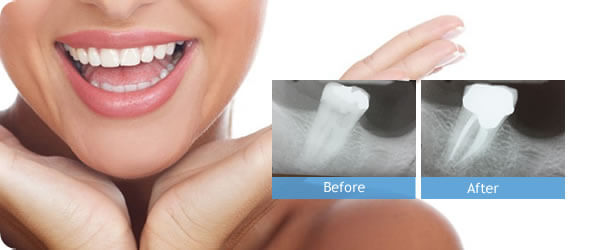Root canal
Tooth cracks, trauma, and decay can sometimes cause infection and irritation of the dental, resulting in the need for a root canal.
WHAT IS A ROOT CANAL?
Root Canal is a treatment used to save and repair a tooth that is badly decayed and infected. It is a conservative procedure used to save a natural tooth to avoid tooth extraction for dental implant or bridge.
“Root canal” is the term used to describe the natural cavity within the center of the tooth. Below the hard exterior surface of the tooth lies the pulp or pulp chamber which is pulp the soft area within the root canal that is made of up of cells and connective tissue.
WHO NEED TO DO ROOT CANAL?
Sometimes no symptoms are present; however, the number one symptom of an infection of the root is pain. Some signs that you may need a root canal include:
- Severe toothache pain upon chewing or application of pressure
- Prolonged sensitivity/pain to hot or cold temperatures (after the hot or cold has been removed)
- Discoloration (a darkening) of the tooth
- Swelling and tenderness in the nearby gums
- A persistent or recurring drainage on the gums
Your doctor will assess your situation during a consultation to see if root canal therapy is right for you
HOW IS ROOT CANAL DONE?
The root canal involves the removal of the infested dental pulp and sealing of the root canal. It consists of the pulp chamber (within the coronal part of the tooth), the main canal(s), and more intricate anatomical branches that may connect the root canals to each other or to the surface of the root.
During a root canal procedure, the nerve and pulp tissue are removed and the inside of the tooth is cleaned and sealed. Without treatment, the tissue around the tooth could become infected and cause an abscess.
This generally involves the use of local anesthesia (or sedative anesthesia for sensitive person) because of the pulp receives nutrition through the blood vessels, and sensory nerves carry signals back to the brain. You will feel pain when the pulp is infected.

Modern techniques have eliminated a lot of the discomfort that has previously been associated with root canals.
At Dr HUNG & ASSOCIATES DENTAL CLINIC CENTER, we use the WAVE●ONE™ instrument to do root canal with some more advantages for the customers as follows:
- Use only one NiTi instrument per root canal in most cases
- Respect of the root canal anatomy
- Reduced rick of a screwing effect and file breakage
- Save time by up to 40% and increases comfort

With some complex root canal treatment cases, we use CT-Cone Beam 3D machine at our clinic to take a X-rays for the customer before treatment to study the abnormal root canal which can’t see by P.A film or Panoramic X-Rays.
The root canal treatment procedure will be more easier and more comfortable for the customers.
Some cases of root canal treatment (Image – before/after) at Dr. HUNG & ASSOCIATES DENTAL CLINIC CENTER:


AFTER TREATMENT
Due to a tooth that needed a root canal is often one that has a large filling or extensive decay or other issues. So, after the completion of your root canal, the final step may involve further restoration of the tooth such as a crown, post-core buildup and crown, or other restoration needs to be placed on the tooth to protect it.
Our doctors will choose a restoration to protect your tooth, prevent it from breaking, and restore it to the full function. At Dr HUNG DENTAL CLINIC CENTER, we have multiple specialists in steam-work to get the best treatment result for you.
To maintain your newly reconstructed tooth, practice excellent oral hygiene and see the dentist every 6 months normally.
For more information please contact:
DR HUNG & ASSOCIATES DENTAL CENTER
Building 244A Cong Quynh , Pham Ngu Lao Ward , District 01 , Ho Chi Minh City
Tel: 08 39257526 – 08 39257527 – 08 39257528
Email: dentalclinicvietnam1@gmail.com
Website: https://dentalclinicvietnam.securepages.info
